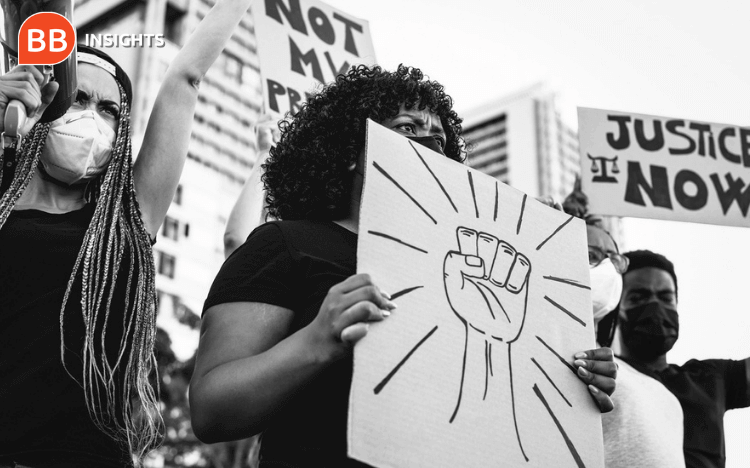Retail—from clothing and beauty to food suppliers—has come under particular scrutiny. More than 60% of Black consumers report experiencing racial discrimination in retail stores, while approximately one-third of minority consumers report experiencing racial discrimination from an advertisement, according to the Journal of Consumer Affairs.
For many ethical and socially responsible consumers waking up in the aftermath of BLM, enough is enough. Millennial and Generation Z consumers are starting to push brands to act on diversity and inclusion.
Millennial and Gen Z consumers demand more
Millennials—born between 1981 and 1996—and Generation Z—born from 1997 onwards—are influencing the retail landscape by pushing brands to reflect their values.
75% of Gen Z consumers will boycott companies that discriminate against race and sexuality across advertisement campaigns, according to a McKinsey study.
Millennials and Gen Z-ers tend to be seen as more socially aware and impact driven, perhaps a result of growing up surrounded by the internet and social media. This in turn has increased their exposure to larger social issues.
“The younger generation has lived through the fluctuating economy, and they've grown up with 1% of the population having the vast majority of the riches, so they have a different perspective on the world today. They perhaps have less to lose in speaking out about inequalities,” says Dr Michele Rogers (pictured right), clinical assistant professor at Northwestern University’s Kellogg School of Management.
Unlike previous generations, who were less willing to embrace difference, younger consumer groups crave uniqueness and individuality. They want the brands they support to reflect these qualities.
Growing up surrounded by a multicultural group of peers is bound to impact their consumer values. They are likely to turn away from companies that disenfranchise their peers or their community.
Generation Z and millennial consumers form the most ethnically and racially diverse adult group in US history, with millennials making up almost a quarter of the American population.

How consumers can influence retail diversity
Consumers possess the power to rally for material change—especially in retail, where they are critical stakeholders in the business’ success or failure.
“Where consumers spend their money becomes votes for what they feel is legitimate. And when the retailer is discriminatory, individuals may behave accordingly and choose not to spend their dollars there,” notes Marcus Collins (pictured right), lecturer of marketing at the Ross School of Business, University of Michigan.
“Ultimately, retailers are commercial institutions,” says Marcus. “If offended consumers and allies refuse to shop at certain stores, there may be severe and significant consequences for the company.”
Social media can also be a powerful tool for consumers to express outrage and hold brands accountable. The #PullUpOrShutUp campaign urged beauty brands to share how many Black people they employed. With influencers’ support, the campaign successfully pressured many companies to reveal this information.

What retail businesses need to do
There are three main ways that businesses could combat racial injustice and pave the way for diversity in the retail industry.
First, retailers should educate their employees on diversity, equity, and inclusion
When R&B singer SZA accused the US department store Sephora of racial discrimination, the company quickly closed its doors to hold diversity training. This relayed a powerful message to its consumers, emphasizing that the company was willing to forego profits to train employees on systemic racism.
If brands speak to customers from minority ethnic groups about their experiences in stores and how they feel advertisements represent them, this valuable information could inform diversity training.
Secondly, retailers should recruit more diversely.
“If leaders in organizations haven't been enforcing D&I practices before, they can't just suddenly expect to improve their business. Companies should learn from customers and employ people at all levels of the organization who reflect the customers they seek,” explains Michele from Kellogg.
By improving diversity training and hiring more diverse staff, brands are likely to see impact in other areas of the business, such as marketing decisions and consumer experience in stores. It will also help employees be better positioned to spot discriminatory behavior.
Thirdly, brands can outline their commitment to supporting ethnic minority-owned brands. Following BLM, American department store Macy's pledged to reserve 15% of their shelf space for Black-owned businesses, to represent the roughly 15% African American population in the US.

Authentic brand activism
Brands need to ensure their responses to social injustices are authentic rather than tokenistic. Consumers are quick to recognize inauthentic actions: Pepsi was forced to pull a controversial advert which viewers accused of ridiculing Black Lives Matter.
Nike has shown that authentic responses to racial injustice can be extremely effective. NFL player and activist Colin Kaepernick fronted Nike’s 2018 Just Do It campaign after he knelt during the national anthem in protest against police brutality. Nike's sales increased by 31% following the advert, suggesting that Nike's millennial demographic appreciated the company’s bold marketing move.
There’s always a risk that brands may seek to capitalize on social movements to woo these socially-minded consumers. Marcus from Michigan Ross notes that it takes looking beyond public gestures of brand activism.
Consumers might look to diversity figures, which more and more organizations feel under pressure to disclose. But these don’t tell the whole story, since representation does not automatically equal inclusion.
To determine whether a brand is putting action behind their words, consumers might wish to investigate the brand’s investment in social causes, their measures to attract a more diverse workforce, and how they’re tackling workplace inequality.
Only time will tell whether brand activists’ efforts to combat racial inequalities result in a long-term change, or whether consumers will expose these corporate efforts as performative responses to social movements.
However, one thing’s for sure: diversity makes business sense. The top quarter of ethnically diverse companies in a McKinsey study outperformed those in the last quarter by 36% in profitability. So, the drive for racial equity in a business is no longer just a moral issue but an economic one, too. Businesses should bear that in mind.
Read next: Companies Are Failing To Deliver On Stakeholder Capitalism
BB Insights explores the latest research and trends from the business school classroom, drawing on the expertise of world-leading professors to inspire and inform current and future leaders
RECAPTHA :
67
88
e7
9c








